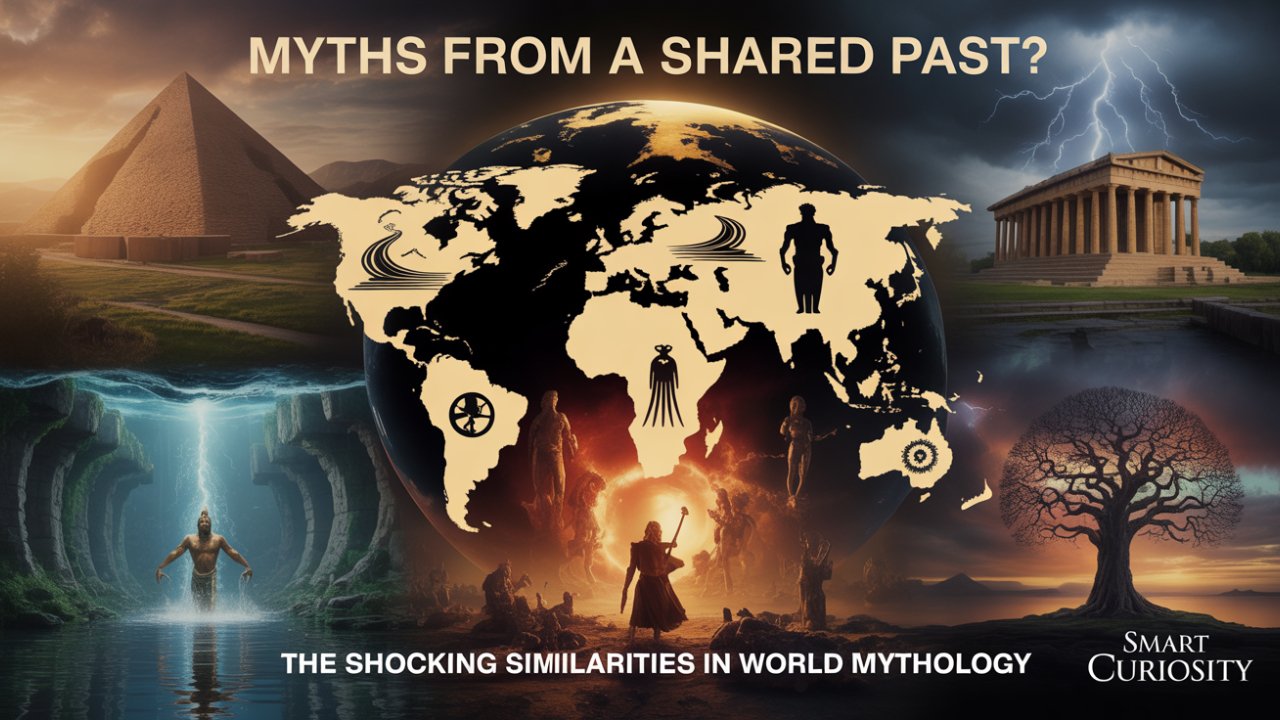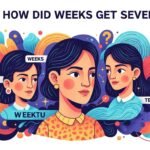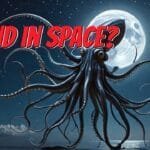Have you ever gotten that strange feeling of déjà vu from a story? The feeling that you’ve heard this tale before, just with different names and in a different setting? A great flood that scours the world clean a hero who leaves home, faces impossible trials, and returns forever changed a universe born from the scattered body of a god
Are these just coincidences? Random quirks of the human imagination, popping up by chance in ancient Sumeria and ancient Mexico, in the frozen north and the jungles of the Amazon? Or is it something more? Could they be echoes of a single, epic story that all of humanity once shared?
Today, we’re uncovering the shocking similarities in world mythology that might just change how you see our ancient past. We’re going on a journey from the cradle of civilization in Mesopotamia to the highlands of Greece and the sacred rivers of India, hunting for the connections that seem to defy explanation. We’re not just retelling old stories; we’re looking for the original story, the one that might just bind us all.
Let’s start with one of the most widespread stories of all time: the Great Flood.
When you hear those words, one story probably comes to mind: a righteous man, a colossal boat, two of every animal, and a world washed clean by divine anger. I’m talking, of course, about Noah and his Ark from the Book of Genesis. It’s a powerful tale of judgment and renewal. God, seeing the wickedness of humanity, decides to hit the reset button. He commands Noah to build an ark, saving his family and the animal kingdom from forty days and nights of rain. The ark lands on a mountain, and from Noah’s family, the world is repopulated. It’s a story so definitive, it feels like it must be one of a kind. But it’s not. Not even close.
Let’s travel back further in time, to ancient Mesopotamia. Inscribed on clay tablets is the Epic of Gilgamesh, one of the oldest literary works ever found. While the written version of Genesis came later, the oral traditions behind it are of unknown age. But what we know for sure is that these clay tablets are older than any written copy of Noah’s story. In the epic, the hero Gilgamesh meets a man named Utnapishtim, who tells a story that sounds eerily familiar.
He says the gods decided to destroy humanity with a flood. But one god, Ea, secretly warned him, telling him to build a giant boat and seal it with pitch. He was to bring his family, craftsmen, and the animals of the field on board. A storm raged that was so terrifying, even the gods grew afraid. When the water subsided, Utnapishtim’s boat landed on a mountain. To check for dry land, he sent out a dove, then a swallow, and finally a raven. When the raven didn’t return, he knew it was safe to make a sacrifice to the gods.
The parallels are mind-blowing. A divine plan to flood the world, a chosen hero, instructions to build a boat, bringing animals aboard, landing on a mountain, and even sending out birds. These aren’t just vague similarities; they’re nearly identical plot points, suggesting the biblical story was likely influenced by this much older Mesopotamian tale.
But the story doesn’t stop there. Over in ancient Greece, we find the myth of Deucalion and Pyrrha. Zeus, disgusted with humanity, decides to wipe them out with a flood. The Titan Prometheus warns his son, Deucalion, to build a chest and float in it with his wife. After nine days, they land on Mount Parnassus. To repopulate the earth, they are cryptically told to throw the bones of their mother over their shoulders. They realize this means the stones of Mother Earth. The stones they throw become the new race of men and women.
And in ancient India, the Matsya Purana tells of Manu, the first man, who saves a tiny fish. The fish grows enormous and reveals itself to be an avatar of the god Vishnu. He warns Manu of a world-ending flood, instructing him to build a great ship and bring aboard seeds, the seven great sages, and pairs of every animal. When the flood comes, Manu ties his ship to the fish’s horn, which guides him to safety on a northern mountain.
A divine being gets angry. A flood is sent to destroy the world. One good person is warned to build a boat, save their family and animals, and lands on a mountain to repopulate the earth. This basic pattern is found in hundreds of cultures across the globe, from the Ojibwe people of North America to the Muisca of Colombia.
So, what’s going on? How did so many separate cultures end up with the same core story? Some theorists point to real historical events. One popular, though still debated, hypothesis suggests the catastrophic flooding of the Black Sea basin around 5600 BCE could be the source. Or maybe it was the rapid sea-level rise after the last Ice Age, an event that would have drowned coastal communities worldwide and burned itself into our collective memory. Whatever the origin, the Great Flood is a story told by the whole world, hinting that our shared history runs much deeper than we think.
If stories about the world’s end are universal, what about its beginning? Creation myths are the foundation of a culture’s worldview, answering the biggest question of all: where did everything come from? And just like with flood myths, we see the same strange ideas popping up in the most unlikely of places.
One of the most common themes is creation from chaos. Today, chaos means a total mess, but in mythology, it was the raw, formless, watery darkness that existed before the ordered universe, the cosmos, came to be. The ancient Greek poet Hesiod wrote that in the beginning, there was only Chaos, a yawning void. From it, the first deities like Gaia (Earth) emerged, and order began to separate itself from disorder.
This isn’t just a Greek idea. The Babylonian creation epic, the Enûma Eliš, begins with a swirling, watery chaos made of two primordial beings: Apsu, the fresh water, and Tiamat, the salt water. Their mingling gives birth to the gods and sets in motion the conflict that will lead to the world’s creation. Even the opening of the biblical book of Genesis describes the earth as without form, and void; and darkness was upon the face of the deep and the Spirit of God moved upon the face of the waters. You see it in Egypt, too, where many myths begin with Nu, a boundless, primordial ocean from which the first land and the creator god Atum arose.
This idea makes a certain intuitive sense. We see order arise from disorder all the time. But there’s another, far more violent and bizarre creation story that appears in cultures separated by thousands of miles: the world being built from the dismembered body of a giant.
In Norse mythology, the story begins with a void where fire and ice met to form a cosmic giant, Ymir. The god Odin and his brothers eventually kill Ymir and begin to construct the world from his corpse. His blood became the oceans and rivers. His flesh became the earth. His bones became the mountains. They used his skull to form the sky and tossed his brains into the air to become the clouds.
It’s a shockingly graphic story. But what’s truly shocking is that it’s not unique. Let’s go from chilly Scandinavia to the warm plains of India. In the Hindu Rigveda, we find a hymn describing Purusha, a cosmic man with a thousand heads and a thousand eyes. The gods sacrifice Purusha, and from his body, the entire universe is born. His mouth became the priestly class, his arms the warriors, his thighs the merchants, and his feet the laborers. Beyond society, his mind became the Moon, his eye the Sun, and his breath the wind. From his head came the sky, and from his feet, the earth.
And back in Mesopotamia, after the god Marduk slays the primordial water-dragon Tiamat, he splits her corpse in two like a dried fish. With one half, he creates the roof of the sky; with the other, he lays down the earth. Her eyes become the source of the Tigris and Euphrates rivers.
So we have this incredibly specific motif a world built from a giant’s body parts in Norse, Hindu, and Babylonian myths. How is that possible? Well, these cultures all belong to the same vast language family: Indo-European. Comparative mythologists have done incredible detective work and reconstructed what they believe is the original, Proto-Indo-European creation myth. They believe the ancestors of the Norse, Romans, and ancient Indians told a story about twin brothers, *Manu (Man) and *Yemo (Twin). In this lost story, *Manu sacrifices his brother *Yemo and builds the world from his body. The stories of Ymir and Purusha seem to be direct descendants of this single, ancient story, carried by migrating peoples across Europe and Asia. It’s some of the most compelling evidence we have for a single, lost human story.
We’ve explored the world’s birth and its near-death. Now let’s turn to the people who walk on it: the hero. Every culture tells stories of heroes who rise above the ordinary and face down impossible odds. And if you strip away the cultural details the Greek armor, the samurai sword, the superhero cape you find the same narrative skeleton underneath. This pattern is so universal it has a name: the Monomyth, or as it’s more famously known, the Hero’s Journey.
The idea was brought to life by the brilliant mythologist Joseph Campbell. In his book The Hero with a Thousand Faces, Campbell argued that these similarities aren’t an accident. He believed they spring from the human psyche itself a collective unconscious filled with universal symbols, or archetypes, that we all share. In this view, the Hero’s Journey is a map for psychological transformation, a guide for navigating the challenges of life.
Campbell’s model can be simplified into three main acts: Departure, Initiation, and Return.
The Departure. The story starts in the ordinary world, where the hero is living a normal, maybe even boring, life. Think of Luke Skywalker, a farm boy dreaming of adventure, or Bilbo Baggins, perfectly content in his cozy hobbit-hole. Then comes the Call to Adventure. A holographic plea for help, a wizard and thirteen dwarves on the doorstep, a summons to war. Something happens that shatters the hero’s reality and presents them with a quest. But often, the hero first Refuses the Call. They’re scared, they feel inadequate, they have responsibilities. It’s our own fear of the unknown played out in story. Eventually, though, they find Supernatural Aid a wise mentor like Obi-Wan Kenobi or Gandalf who gives them a tool, training, or a much-needed push. Finally, the hero Crosses the First Threshold, leaving their known world behind and stepping into a realm of danger and wonder. It’s the point of no return.
The Initiation. Now on the Road of Trials, the hero faces a series of tests that force them to grow. Hercules completes his Twelve Labors. The Hindu hero Rama battles demons to rescue his wife, Sita. These trials often lead to a moment of total crisis, a symbolic death and rebirth Campbell called the Belly of the Whale. The hero hits rock bottom, descending into darkness literally or metaphorically. But it is in this darkest moment that they are reborn, emerging with a new understanding. Having survived, the hero achieves their goal: the Ultimate Boon. This could be a treasure like the Golden Fleece, the rescue of a princess, or a moment of enlightenment, like the Buddha achieving nirvana.
The Return. The journey isn’t over. The hero must bring their prize back to the ordinary world, a trip that can be just as dangerous. They must Cross the Return Threshold, re-entering a home that may not recognize them, or a world that no longer feels the same. Odysseus returns to Ithaca disguised as a beggar, a stranger in his own house. Finally, the hero becomes the Master of Two Worlds. They have integrated their adventure into their life, bridging the gap between the spiritual and the material. They share their wisdom, revitalizing their society.
This pattern is the blueprint for everything from The Lord of the Rings to The Matrix to Harry Potter. While some critics argue the model can be a bit of a one-size-fits-all, its power is undeniable. The shocking similarity of the hero’s journey across cultures suggests it’s more than a storytelling trick. It’s our story a symbolic map of the human journey from childhood dependency through adult trials to mature wisdom.
So, we’ve seen the patterns. In stories of global floods, cosmic creation, and heroic quests, the same core ideas repeat again and again. We’re faced with an undeniable web of connections. So the big question is… why? What do these echoes in our myths really mean? The answers are as fascinating as the myths themselves.
The first, and most direct, explanation is Cultural Diffusion and Shared Heritage. This theory says that myths travel. They spread from culture to culture through migration, trade, and conquest. Stories are passed down just like genes and languages. The strongest evidence for this comes from that Proto-Indo-European connection we talked about. Scholars have traced not just a parent language, but a parent mythology.
Think of the Sky Father god. In Greece, he’s Zeus Pater. In Rome, he’s Jupiter. In ancient India, he’s Dyauṣ Pitṛ. The names are all linguistically related, pointing back to a single Proto-Indo-European god: Dyēws Ph₂tḗr. The same goes for the myth of a thunder god slaying a great serpent. We see it with the Norse god Thor battling the World Serpent, the Indian god Indra slaying the serpent Vritra, and the Greek god Apollo slaying the Python. This strongly suggests a proto-myth that existed thousands of years ago and was carried by migrating tribes, who then adapted it to their new homes.
But diffusion can’t explain everything. What about the flood myths in the Americas, from cultures separated from Eurasia for millennia? This leads to our second major theory: Psychological Archetypes.
Pioneered by psychiatrist Carl Jung, this idea suggests that the human mind isn’t a blank slate. We all inherit a collective unconscious, a deep psychic layer containing archetypes universal, instinctual patterns and images. The Hero is an archetype for the journey to selfhood. The Wise Old Man is an archetype for guidance. The Great Mother, both nurturing and destructive, is an archetype. The Shadow, our dark side, is the monster the hero must face. In this view, myths are similar because they all draw water from the same deep, human well. They aren’t just stories about the world; they’re maps of our inner selves.
A third theory blends the others: Independent Invention from a Shared Experience. This idea suggests that different people could come up with similar myths simply because we’re all human. We all live on the same planet, with the same brains. We all experience the rising sun, the changing seasons, birth, death, love, and fear. It’s logical we’d invent similar stories to make sense of it all. It’s possible ancient stories, like one called the Cosmic Hunt, have been traced back tens of thousands of years, suggesting they may have traveled with the very first humans out of Africa. This blends all three ideas: an ancient, diffused story, whose archetypal power allowed it to survive, constantly adapted to local experiences.
So which theory is right? The truth is, it’s probably a mix of all three. Some parallels are clearly from shared ancestry. Others seem to tap into something deep in our psychology. And many are surely born from the simple, shared fact of being human.
We started by asking if the similarities in our myths were just a coincidence. We’ve seen how stories of a world-ending flood, a cosmos born from a slain giant, and a hero’s transformative journey belong not to one culture, but to all of us.
These recurring tales could be the fragmented memories of our ancient ancestors, their stories scattering like seeds across the globe. They could be bubbling up from a deep, collective part of our minds, expressing universal truths in the language of symbols. Or they could simply show that being human means asking the same questions and facing the same fears, no matter who or where you are.
The real answer is likely a tapestry woven from all these threads. But the final conclusion is inescapable: these stories connect us. They show that for all our differences, our ancestors dreamed the same dreams. They looked at the night sky and saw the skull of a giant. They feared the power of water but also saw its promise of rebirth. And they knew, on a deep, primal level, that life is a journey of leaving home, fighting dragons, and returning changed.
These myths are our oldest inheritance. They are not just quaint fairy tales from a primitive past, but a profound and enduring testament to the unity of the human spirit. Long before we were connected by satellites and fiber optics, we were already telling one great, global story.
So what do you think? Which theory makes the most sense to you? And what other incredible mythological parallels have you come across? Share your thoughts in the comments below we’d love to read them. Thanks for watching.





